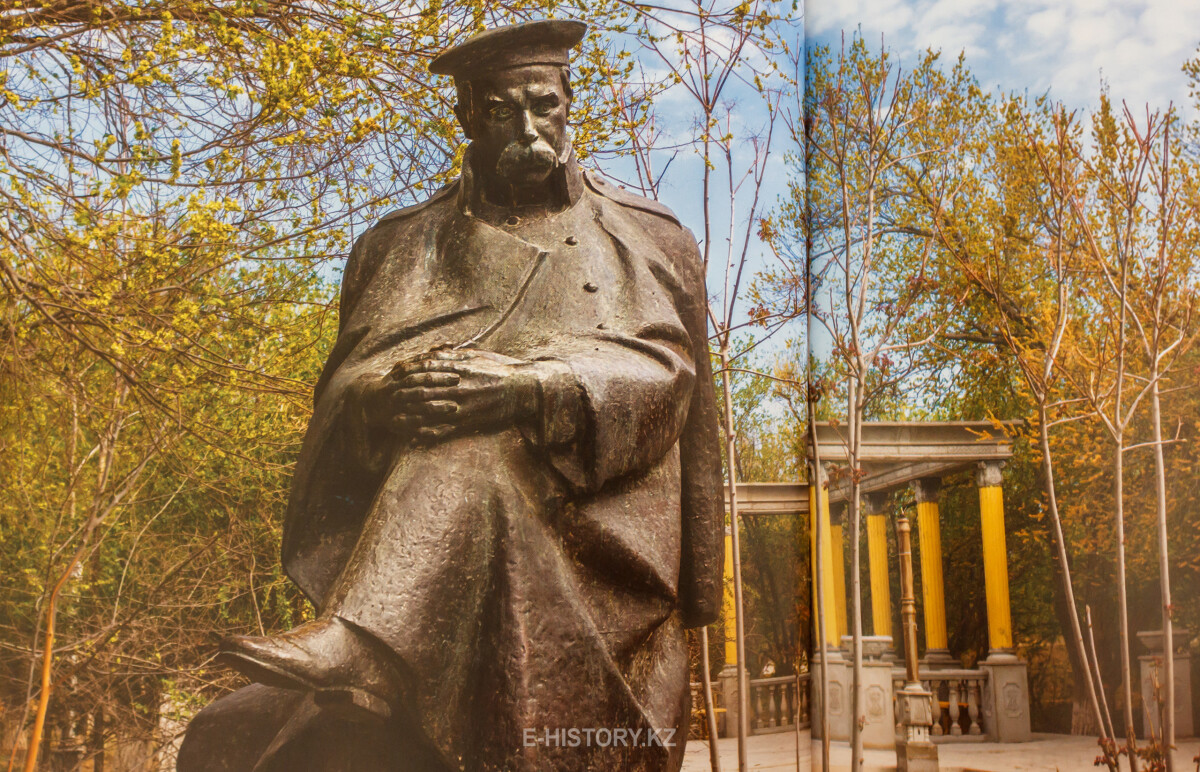
Dramatic events in the life of Shevchenko led him to the lands of Kazakhstan. The poet got to know the locals and his impressions from the time passed there in exile found their reflection in his poems.
On March 9th 1814, the ancestor of pre-Baltic barons, senator and general V. Engelgardt, who owned tens of thousands of peasants in different governorates of Russia, had an addition to his property stock. In the peasant family of Hryhoriy and Katerina Shevchenko a son was born, who was then christened under the name Taras. This happened in the town of Morintsi, which is about 200 kilometers away from Kiev. After two years the family moved to the neighbouring town of Kyrylivka, which was under the ownership of V. Engelhardt as well. These were places of rare natural beauty, enveloped in the memories of historical events. Taras’ gift of a future painter and thirst for the art of poetic expression were revealed early on, even though it was not obvious even to himself. In 1825, when he turned 11 years, Taras’ father died. In accordance with tradition, upon bequeathal of his meagre possessions, Hryhoriy Shevchenko said: “My son Taras does not need anything that I can offer. He is not going to be like everyone else. He is going to become something great or something still unimaginable, and my possessions will mean nothing to him nor will they help him in any way.”
Having become an orphan at an early age, despite his lamentable fate, Taras was possessed by the desire to learn. He starts going from clerk to clerk, who in those days were the only literate educators in the towns, always with the similar request - “teach me”. Later, in his novel “Knyaginya” he recollects: “I was always wearing a grey overcoat full of holes and a constantly dirty shirt. And the hat and boots, well those I never had - neither in the summer or winter”. At that time he was 13 years old.
.jpg)
“Parable of the Prodigal Son”
In 1829, together with a great number of servants, Engelgardt moves to Vilno and this is where the serious and respectable icon-painter, who saw Taras’ talent and agreed to teach him his art, was found. But for this, the landlord’s permission was needed because at that time the young Shevchenko was already part of his labor force. At that time the young Engelgardt was in the middle of gathering a number of house servants and that is when he was approached by the “stray apprentice”, who, as Engelgardt was told, had the potential to be a “household painter”. That is how Taras became the personal servant of the landlord. He had to endure a lot from the soulless “teachers” and baron’s lackeys, and the insults that were aimed at reminding him that he was a serf, without rights, would forever stay in his memory. Despite everything, he continued to paint any free minute that he got, slowly forming his own worldvision and understanding of the way society works. Ahead, the most significant and truly marvelous in terms of the number of unexpected turns, period of his youth awaited him - the time he spent in St. Petersburg where he moved with the numerous entourage of Engelgardt’s servants. This happened in 1831. After one year of “relentless demands” of the young artist, the baron landlord agreed to getting him into an educational training under the guidance of master painter V. Shiriayev. Thus, young Shevchenko gained access to serious literature and got to familiarize himself with a great collection of etching prints.
During the white St. Petersburg nights he secretly made his way to the Summer garden and there painted copies of the antique statues of deities that were standing in the alleys. One day, when Taras got to drawing the statue of Saturn, he met a fellow compatriot and painter I. Soshenko, thanks to whose recommendation the Society for supporting artists became interested in him. During his time off from work, Shevchenko started attending painting classes and sometimes received modest monetary support. But the most important was to free Shevchenko from his serfdom because a painter and a serf were incompatible ways of life. What’s more, the Academy of Arts, just as other higher educational institutions, did not admit indentured serfs. But a solution was found - Shevchenko was bought out of serfdom for 2500 roubles. This happened on April 22nd, 1838. This meant freedom from bondage, from the possibility of being sold or returned to the service of a household servant and at the same time, opportunity to study. This was truly a day of rebirth for Shevchenko, and the world of art owes this, first and foremost, to the Russian intelligentsia, which did everything it could to liberate the future poet and painter. That is how Shevchenko commenced his studies at the Academy of arts and the years spent there contributed especially a lot to his mastership. Having just come out of serfdom, in a just a number of years he surpassed many of his colleagues who had a much better off upbringing, yet he still remained humble in the way he communicated with those around him, was sensitive, exuberant, direct and unwilling to betray his ideas of “masculine” democracy. According to Shevchenko, he started writing poetry simultaneously as he started drawing the statues in the Summer garden. From these early efforts, the records of which have disappeared without a trace, Taras published only the ballad “Perebendya”, which opens the poetry collection “Kobzar”. This collection was published in 1840 and included 8 works: lyrical poems, ballads and poetry.
By choosing the title “Kobzar”, the author also presented himself as the voice of the people, directly connected with the working peasants, their world, life, ideas and visions.
.jpg)
“Kazashka Katya”
As a painter, Shevchenko starts to take part in various exhibitions and is awarded silver medals three times for his works. The waterpainting “Tsyhanka-vorozhka”, for which he was awarded his third silver medal has still been preserved to our days. But Shevchneko’s most outstanding work during his time at the Academy of arts is his “Autoportrait”, an oil painting from 1840. This was already a work that showed the author’s independent style and originality.
In 1843, during the summer vacation, Shevchenko visits Ukraine, after a 15 year absence. The result of the visit - “Zhivopisna Ukraina” (Pictorial Ukraine), an album of works dedicated to peasant life. In 1845 Shevchenko completes his studies at the Academy of Arts and moves to Ukraine. Inspired by his experience there, he writes an entire sequence of revolutionary works under the common title “Tri lita” (Three years). It was basically this collection of works which played a fateful role in his life. In 1847 he was arrested and was enlisted into the army “with a strict prohibition to paint or write”. On June 9th, 1847 he was transported to Orenburg and from there sent to the Orsk fortress where he was enlisted as the soldier of the 3rd squadron of the infantry division.
Shevchenko took part in the Aral expedition in 1848-1849 under the leadership of the Russian researcher and marine explorer A. I. Butakov. This was quite a productive period for him and he produced more than 70 works of poetry and more than 160 drawings. Shevchenko’s artworks from this period are distinguished by incredible detail and meticulousness - the shores of the Aral sea, the virgin nature of the islands, mountains and cliffs, plant and animal life of the places visited. That is why many of Shevchenko’s drawings were included into the album that was attached to the report on the expedition. And thanks to these drawings it was possible to get a fuller picture of the place of his exile.
In spring of 1850, as a result of lieutenant N. Isayev’s denouncement to authorities, Taras Shevchenko was once again arrested for disobeying the tsar’s order of “no writing and no painting”.
.jpg)
Mangyshlak garden, established 7 kilometers away from the Novopetrovskaya fort. Among the cliffs there were a lot of agrestic trees.
This was the new place of exile for Shevchenko, which was built in 1846, on the eastern coast of the Caspian sea, on the Mangyshlak peninsula, where he was transported on October 17, 1850. This is where the most difficult period of Shevchenko’s life commenced. He was placed under very strict supervision and conditions there were dreadful. The officers, with the intent to break his spirit and degrade him, tormented him with daily strict regiments and patrols. But even in these incredibly difficult conditions Shevchenko created a great number of artistic and literary works. At the Novopetroskoye fort he wrote about 20 prose novels, of which only nine were preserved.
But his works as a painter were the ones that were the most outstanding. Shevchenko was surrounded by a lot of people who were very sympathetic towards him and tried to make things easier for him. Shevchenko worked on paintings of landscapes, drawings capturing the historical moments and daily life, as well as portraits. Shevchenko’s interest in cultural monuments, the ethnography of Kazakh people was expressed in his sketch-drawings of architectural structures, tombs, memorials, headstones, of which there were many in Mangyshlak, particularly in the vicinity of the Novopetrovskoye fort.
Irakliy Uskov served in the Novopetrovskoye fort as a superintendent. He played a positive role in Shevchenko’s life.
Uskov practically granted him the right to paint and write, opened the doors of his home to him and freed him from the obligations of the daily regiment. Uskov saw a great talent in Shevchenko and in order to protect him from denouncements to authorities, he allowed him to hide his works in a dugout shelter. That is why these works were preserved.
.jpg)
Another great deed of Uskov was granting Shevchenko a vacation from the service to travel to St. Petersburg without having to pass through Uralsk and Orenburg. Uskov’s name is mentioned in almost all of Shevchenko’s letters from Mangyshlak, which were written in the period of 1853-1857, as recorded in his diary. After departure from the Novopetrovskoye fort Shevchenko kept exchanging letters with Uskov.
The first time Shevchenko mentions his freedom is in an entry in the diary dated on June 13th, 1857: “On May 2nd I received a letter from St. Petersburg from Mihail Lazarevskiy along with 75 roubles that were enclosed. He informed me or rather congratulated me on my free status. However, there are still no news from the headquarters and while I wait for it, I am gathering information about the Volga steamship nagivation”.
On August 2nd, 1857 Shevchenko leaves Mangyshlak for good and by way of Astrakhan-Novgorod-Moscow heads out towards St. Petersburg. Having regained his freedom and opportunity to continue his work, he completely devoted himself to writing and painting.
Unfortunately, after his release, fate did not grant Shevchenko that much time, but even in the remaining four years he was incredibly productive. In 1860 he was awarded the academic degree of a master of engraving. On March 10, 1861 Taras Shevchenko died.
Shevchenko inspired many Kazakh poets, writers and painters. Zhambyl Zhabayev dedicated a poem to him titled “Taras, where the lyrical hero is portrayed as the defeender of the people, fighter for the rights of the weak and oppressed. Zhabayev called himself and Shevchenko brothers, who sing of the great truth.
On March 13ths, the Culture and Information center of Ukraine organized an event dedicated to Taras Shevchenko.
Materials from the book “Mangistau v sud’be Kobzarya” (Mangistau in the fate of Kobzar) were used.
State Municipal Management Organization “Museum Complex”, Cultural Administration of Mangistau region

